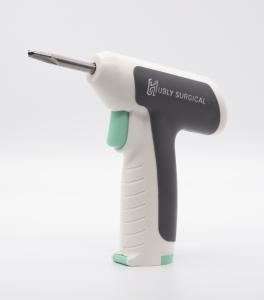
Hubly Raises >$1M to Improve Efficiency/Outcomes of Bedside Cranial Drilling with New Drill. Seeks Research Partners
Advanced Cranial Drill Maker, Hubly Surgical, Seeking Research Partners After Successful Seed Round
Hubly is now seeking collaborative research partners in addition to Northwestern Medicine and UMass Memorial Health with whom they currently work. Institutions and their physicians will receive hands-on training and will participate in the development of standard operating procedures (SOPs) related to emergency bedside intracranial access surgery, also known as burr hole drilling, craniotomy, and skull trephination. The electric drill is intended to replace the hand-crank drill commonly used today to perform this procedure when neurosurgeons and operating rooms with advanced intracranial surgical technologies are not available.
“People are amazed at how incredibly low-tech the manual crank procedure still is today for craniotomies at the bedside. When we tell them we’re helping doctors go from two-handed drilling to these obvious safety and ease of use features, they’re amazed the technology hasn’t arrived sooner,” said Casey Grage, CEO and Co-founder of Hubly Surgical. “The aim is for our electric cranial drill to become the new standard for this critical procedure that’s performed 400 times per week in the US.”
Understanding the Cranial Access Drilling Procedure and the Improvements Achieved with the New Electric Drill from Hubly:
Bedside cranial access procedures are commonly performed as an immediate, often life-saving maneuver to relieve elevated intracranial pressure. There are a few ways in which this pressure may persist in the brain, but one of the more common is a condition called hydrocephalus.
When cerebrospinal fluid is flowing normally it bathes the brain and spinal column and provides cushioning and vital nutrients. Hydrocephalus occurs when there is an over production and/or lack of proper reabsorption of spinal fluid. Patients can be hydrocephalic as a result of traumatic brain injury, intracranial hemorrhage, aneurysm, stroke, or it can develop with age. Also, some babies are born with hydrocephalus. Left untreated it can lead to permanent brain damage and death.
Research indicates that the faster hydrocephalus is diagnosed and relieved by properly drilling a hole in the patient’s skull and inserting a drainage cannula, the better the chance of recovery to normal brain health with no cognitive impairment. The holes, commonly referred to as burr holes, need to be drilled to the precise depth of the patient’s skull thickness. The cranial access drilling procedure is routinely performed by non-neurosurgeons in the emergency room (ER) of hospitals and clinics. Resident medical students train on cadavers to develop a “feel” for the hand drill nearing and protruding from the underside of the patient’s skull and stopping the cranial drill bit before hitting brain matter. Additional reasons for performing intracranial access drilling include cancers of the nervous system, brain tumors, unresolved epileptic seizures, and subdural hematomas, totaling well over 205,000 total intracranial access procedures performed annually in the U.S.
A video demonstrating traditional hand drilling of burr holes for cranial access is viewable at www.hublysurgical.com/why-hubly. This same link provides another video in which support for the advancement of this device and procedure is offered by distinguished neurosurgeon and professor of neurosurgery, Dr. Matthew Potts of Northwestern University.
“Boring into a person’s skull with a hand drill is fraught with potential problems and adverse events. Residents simply do the best they can with the tools and training they’re given today. Why not make the process as simple as it can be?” adds Grage. “Our mission is to dramatically improve patient outcomes for this procedure while reducing dependency on operating rooms and cutting down on costs. The future is also bright for other indications.”
(An indication is a disease or condition the device will treat, prevent, or mitigate. There are multiple indications beyond hydrocephalus where a physician may utilize cranial access drilling. Research is underway to expand into other indications, including fields beyond neurosurgery, such as orthopedics and dentistry.)
Key Improvements Offered by Electric Drilling:
Innovative features of the Hubly Electric Drilling (HED) System include battery power; sensor technology which automatically stops the surgical drill bit immediately upon skull puncture; hardware catheter guidance to mitigate catheter misplacements for external ventricular drain procedures; and advanced ergonomics influenced by an expert team of neurosurgeons and medical instrument designers. The system will ultimately come as a complete kit with varying sized drill bits uniquely designed by Hubly to provide hardware safety in design and prevent bone snagging. Catheters and tubes used in the ventricular catherization procedure after drilling are purchased separately. (Supply chain managers should be aware of the differences in the ventriculostomy procedures their surgeons perform which necessitate either an intraventricular catheter (IVC) or external ventricular drainage (EVD) tube, or both, to connect the ventricles of the brain to an external collecting device.)
Decision makers at Level 1 trauma centers and other medical and healthcare facilities interested in participating in clinical trials of the HED System from Hubly Surgical are encouraged to submit an application for collaborative research at: www.hublysurgical.com/trials-interest-form
Casey Grage
Hubly Surgical
+18884825942 ext.
casey@hublysurgical.com
Visit us on social media:
LinkedIn
Distribution channels: Banking, Finance & Investment Industry, Electronics Industry, Healthcare & Pharmaceuticals Industry, Science, Technology
Legal Disclaimer:
EIN Presswire provides this news content "as is" without warranty of any kind. We do not accept any responsibility or liability for the accuracy, content, images, videos, licenses, completeness, legality, or reliability of the information contained in this article. If you have any complaints or copyright issues related to this article, kindly contact the author above.
Submit your press release
